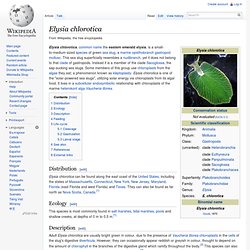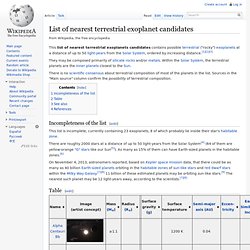

Elysia chlorotica. Distribution[edit] Elysia chlorotica can be found along the east coast of the United States, including the states of Massachusetts, Connecticut, New York, New Jersey, Maryland, Florida (east Florida and west Florida) and Texas.

They can also be found as far north as Nova Scotia, Canada.[1] Ecology[edit] This species is most commonly found in salt marshes, tidal marshes, pools and shallow creeks, at depths of 0 m to 0.5 m.[1] Description[edit] Feeding[edit] The incorporation of chloroplasts within the cells of Elysia chlorotica allows the slug to capture energy directly from light, as most plants do, through the process known as photosynthesis. Life cycle[edit] Cleavage[edit] Gastrulation[edit] Elysia chlorotica gastrulation is by epiboly: the ectoderm spreads to envelope the mesoderm and endoderm.[3][broken citation] The 100 Best Books of All Time. Many publishers have lists of 100 best books, defined by their own criteria.

This article enumerates some lists of "100 best" books for which there are fuller articles. Among them, Science Fiction: The 100 Best Novels (Xanadu, 1985) and Modern Fantasy: The 100 Best Novels (Grafton, 1988) are collections of 100 short essays by a single author, David Pringle, with moderately long critical introductory chapters also by Pringle. For publisher Xanadu, Science Fiction was the first of four "100 Best" books published from 1985 to 1988. The sequels covered crime & mystery, horror, and fantasy. List of nearest terrestrial exoplanet candidates. This list of nearest terrestrial exoplanets candidates contains possible terrestrial ("rocky") exoplanets at a distance of up to 50 light-years from the Solar System, ordered by increasing distance.[1][2][3] There is no scientific consensus about terrestrial composition of most of the planets in the list.

Sources in the "Main source" column confirm the possibility of terrestrial composition. Incompleteness of the list[edit] This list is incomplete, currently containing 23 exoplanets, 8 of which probably lie inside their star's habitable zone. There are roughly 2000 stars at a distance of up to 50 light-years from the Solar System[4] (64 of them are yellow-orange "G" stars like our Sun[5]).
Table[edit] In September 2012, the discovery of two planets orbiting Gliese 163[35] was announced.[36][37] One of the planets, Gliese 163 c, about 6.9 times the mass of Earth and somewhat hotter, was considered to be within the habitable zone, but is probably not terrestrial.[36][37] Kirlian photography. Kirlian photograph of two coins Kirlian photography is a collection of photographic techniques used to capture the phenomenon of electrical coronal discharges.

It is named after Semyon Kirlian, who in 1939 accidentally discovered that if an object on a photographic plate is connected to a high-voltage source, an image is produced on the photographic plate.[1] The technique has been variously known as "electrography",[2] "electrophotography",[3] "corona discharge photography" (CDP),[4] "bioelectrography",[2] "gas discharge visualization (GDV)",[5] "electrophotonic imaging (EPI)",[6] and, in Russian literature, "Kirlianography".
Kirlian photography has been the subject of mainstream scientific research, parapsychology research and art. To a large extent, It has been co-opted by promoters of pseudoscience, fringe science and paranormal health claims in books, magazines, workshops, and web sites.[7][8] History[edit] In 1889, Czech B. In 1939, two Czechs, S.